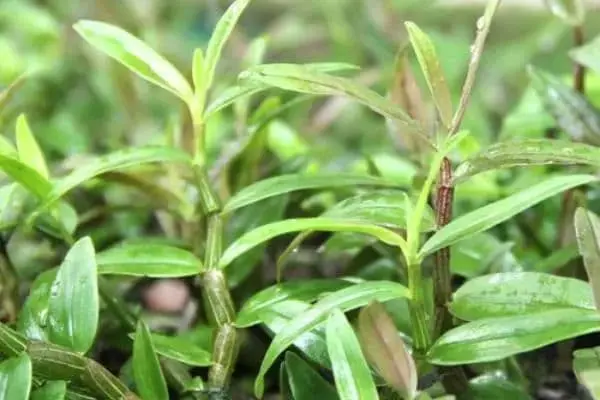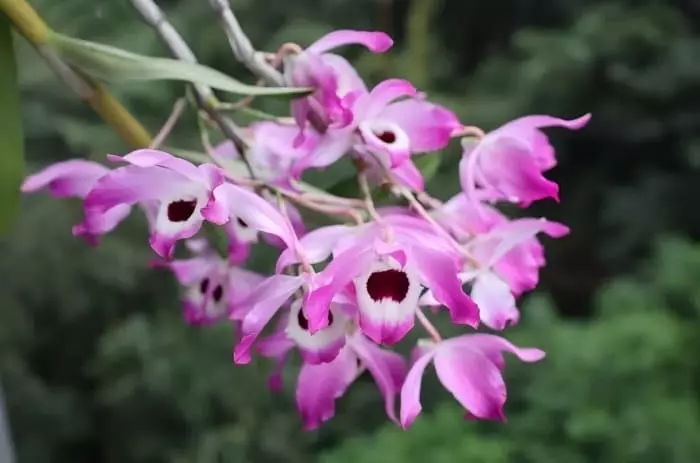We know that there are many categories of dendrobium, dendrobium hairpin is one of them.
Dendrobium is very demanding on the natural growth environment, the atmosphere, soil, water quality requirements, fear of cold, like high temperature and high humidity, the average annual temperature is higher than 18 degrees Celsius, the winter temperature is higher than 3 degrees Celsius, the frost-free period is greater than 350 days or more, and so on.

Dendrobium hairpin, also known as dendrobium hairpin, flat hairpin, flat yellow grass, flat grass, is a perennial herb, shaped like an ancient hairpin on the head and named.
Its stem is slightly flat, wide in the middle and narrow at both ends, the surface of golden yellow or greenish yellow, with gloss, also known as hanging orchids in folklore.
Dendrobium officinale is mainly distributed in Guizhou Chishui, Xishui and Sichuan Luzhou area.
Among them, especially in Guizhou Chishui Dendrobium Chinense is the best, the State General Administration of Quality Supervision, Inspection and Quarantine in March 2006 approved the Chishui Dendrobium Chinense as a national geographical indications for the protection of products.
Effects of Dendrobium Nobile

The Compendium of Materia Medica says it has the efficacy of ‘strengthening the yin and benefiting the essence, thickening the stomach and intestines, making up for the insufficiency of the internal spores, and lightening the body and prolonging the life’.
Instead of tea, it is good for throat and voice; it is also good for anti-bacterial, anti-cancer and aging.
Its main effects are as follows:
1、Anti-aging, improve immunity

Dendrobium officinale can significantly increase the level of superoxide dismutase (SOD), reduce lipid peroxide (LPO), regulate the level of cerebral monoamine neuromediators, inhibit similar monoamine oxidase (MAO), and play a role in slowing down the aging process.
Dendrobium polysaccharides also have significant immune-enhancing activity and a variety of effects such as anti-aging and anti-radiation.
2、Improve cardiovascular function

Dendrobium officinale contains ester components, which have the ability to activate blood circulation and remove blood stasis, dilate blood vessels and anti-platelet coagulation.
It is useful in the treatment of thromboembolic vasculitis, cerebral thrombosis and arteriosclerotic occlusion.
3、Anti-tumour

The phenanthrene and bibenzyl substances extracted from Dendrobium chrysogenum have anti-lung cancer, ovarian adenocarcinoma and promyelocytic leukaemia.
It can promote the growth of T-cells and the production of inhibitory factors by lymphocytes, and play an immune-enhancing role.
The ethyl acetate extract of Dendrobium officinale has significant cytotoxic effects on human lung cancer cells, human ovarian adenocarcinoma cells, and human promyelocytic leukaemia.
4、Treatment of digestive system diseases

Dendrobium officinale has an excitatory effect on the intestinal tube, which can increase the amplitude of contraction.
Dendrobium alkaloids and non-citrulline have similar efficacy but weaker effects, and dendrobium extract can stimulate the contraction of small intestinal smooth muscle and promote gastrointestinal peristalsis.
It can receive unique and satisfactory effect on chronic atrophic gastritis.
What are the differences compared to Dendrobium
1, appearance
Dendrobium flowers are pinkish-white in colour, and the anterior part of the flower is gradually inclined to purplish-red, and each flower has six petals.
While the flowers of Dendrobium show yellowish colour, the flowers on each scape are less than seven or eight, and more than twenty or even more, each flower also has six petals, and it shows the flower shape like four sides spreading.
2、Mouthfeel
Dendrobium alkali content and polysaccharide content of the difference.
The content of dendrobine in Dendrobium and Dendrobium iron skin is less than that of Dendrobium, which is the reason why Dendrobium is bitter and Dendrobium iron skin is not bitter.
3、Composition
The scientific study showed that the relative integral area sum of the peaks with even mass number of electrospray ionisation mass spectra was 2.34% and 41.87% in Dendrobium ironum and Dendrobium alpinum, respectively.







